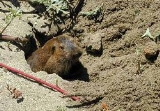
Smooth-toothed pocket gopher
Encyclopedia
The smooth-toothed pocket gophers, genus Thomomys, are so called because they are among the only pocket gopher
s without grooves on their incisor
s. They are also called the Western pocket gophers because they are distributed in western North America
. They are considered distinct enough from other pocket gophers to be recognized as a separate subfamily or tribe.
. They rely on their incisors for digging more than most other gophers. They feed on plants, largely from beneath the surface, but they do come above ground at night. Root
s, stems
, leaves
, and bulbs are eaten. When not directly in an agricultural field they are a benefit to humans by enriching soil and preventing runoff.
Pocket gopher
The pocket gophers are burrowing rodents of the family Geomyidae. These are the "true" gophers, though several ground squirrels of the family Sciuridae are often called gophers as well...
s without grooves on their incisor
Incisor
Incisors are the first kind of tooth in heterodont mammals. They are located in the premaxilla above and mandible below.-Function:...
s. They are also called the Western pocket gophers because they are distributed in western North America
North America
North America is a continent wholly within the Northern Hemisphere and almost wholly within the Western Hemisphere. It is also considered a northern subcontinent of the Americas...
. They are considered distinct enough from other pocket gophers to be recognized as a separate subfamily or tribe.
Natural history
Thomomys is highly fossorialFossorial
A fossorial organism is one that is adapted to digging and life underground such as the badger, the naked mole rat, and the mole salamanders Ambystomatidae...
. They rely on their incisors for digging more than most other gophers. They feed on plants, largely from beneath the surface, but they do come above ground at night. Root
Root
In vascular plants, the root is the organ of a plant that typically lies below the surface of the soil. This is not always the case, however, since a root can also be aerial or aerating . Furthermore, a stem normally occurring below ground is not exceptional either...
s, stems
Plant stem
A stem is one of two main structural axes of a vascular plant. The stem is normally divided into nodes and internodes, the nodes hold buds which grow into one or more leaves, inflorescence , conifer cones, roots, other stems etc. The internodes distance one node from another...
, leaves
Leaf
A leaf is an organ of a vascular plant, as defined in botanical terms, and in particular in plant morphology. Foliage is a mass noun that refers to leaves as a feature of plants....
, and bulbs are eaten. When not directly in an agricultural field they are a benefit to humans by enriching soil and preventing runoff.
Species
Over a hundred subspecies have been described, but not all are currently recognized by modern authorities. Like many fossorial rodents, Thomomys shows a great deal of allopatric variation.- Thomomys
- Subgenus Megascapheus
- Thomomys clusius - Wyoming Pocket Gopher
- Thomomys idahoensis - Idaho Pocket Gopher
- Thomomys mazama - Western Pocket Gopher (including the extinct subspecies Thomomys mazama tacomensis - Tacoma Pocket Gopher)
- Thomomys monticola - Mountain Pocket Gopher
- Thomomys talpoides - Northern Pocket Gopher
- Subgenus Thomomys
- Thomomys bottae - Botta's Pocket Gopher
- Thomomys bulbivorus - Camas Pocket Gopher
- Thomomys townsendii - Townsend's Pocket Gopher
- Thomomys umbrinus - Southern Pocket Gopher
- Subgenus Megascapheus

